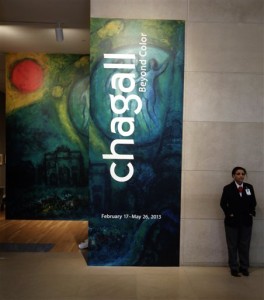If you’re anything like me, you probably keep a mental notebook of museums that seem to do consistently interesting work; it’s pages filled with the names of people you’d want to work with or museums you’d like to be at if the opportunity arose. My list has quite a few names on it, but one that has been near the top for a while is the Dallas Museum of Art, so it was enormously cool to spend a week at the DMA following Museums and the Web this year.

DMA Deputy Director Rob Stein
The DMA has been of interest to me for a number of reasons, but primarily because its mission and approach seems to align with much that I value in museums. It has an emphasis on transparency, dialogue and participation, ethical practice, scholarship, and even taking informed risks (yes! Risk is built into the mission). Under the leadership of Director Maxwell Anderson and Deputy Director Rob Stein, the museum appears progressive, innovative and interesting, and consistently looking to new ways of thinking about museum practice like opening up museum membership to anyone who wants to join it, for free – so it ticks all of my boxes.
So what did I learn from a week there? In short, a lot. As well as spending a significant amount of time with Rob, I had meetings with a number of high-level staff, sat in on general staff meetings, and lingered long in the museum observing visitors and thinking about the dynamics of the space. The takeaways are too many for a single post, so I’m going to run a short series of reflections from my week as museumgeek-in-residence at the DMA. This is the first.
DMA Reflection One: Confident, comfortable staff make for confident, comfortable visitors
While the DMA’s simultaneous introduction of free museum entry and DMA Friends were perhaps the most noteworthy moves it has made towards visitor engagement in recent times, they have not happened in isolation. A less-documented but equally interesting shift in the museum has been in the role of visitor services staff, who are no longer expected to simply guard the museum space, but to take a far more proactively open approach to guest engagement. A member of staff greets visitors upon entry to the museum; another waits near the sign-up stations for the Friends program to assist anyone who needs help. Floor staff through out the museum make eye contact and nod or say hello when guests approach. It’s an approach that reminds me of Disney’s concept of being “assertively friendly” to provide exemplary guest service.
This change in the manner of the floor staff to visitors dovetails nicely with the broader emphasis on relationships found in the DMA Friends program, but is also indicative of a more general cultural change in the institution. For staff who have worked on the museum floor for a decade or longer, the difference in attitude and expected actions is significant. Even the uniforms of floor staff are now different, with a move away from formal jackets and towards more comfortable polo shirts (something which has left some feeling a bit vulnerable without the authority of their prior uniform, but also more open). This change might seem superficial, but comfortable staff make for comfortable visitors.
Cultural change does not happen overnight. One of the most important elements for bringing in change is equipping staff with skills and strategies for coping with the new expectations of their new role; something the DMA and its Director of Visitor Services, and Visitor Services Staff Barbee Barber seems to be approaching proactively. Visitor services staff are given a 15 minute briefing before every shift, as well as attending weekly training. During the training session I sat in on, two members of visitor services staff – David Caldwell and Joe Delinski – had each gone out of their way to research a topic they were personally interested in that was also related to the DMA Friends program to teach other members of the team (itself a great idea for encouraging internal staff development).
Joe’s talk was on gamification and gameplay as they relate to DMA Friends, a subject he was passionate about because Joe is himself a gamer. David spoke on the datafication of concepts, and the idea of “quantifiable social opportunities” and the “cumulative quantity of positive impressions [on visitors]” that the DMA floor staff could make. His talk emphasised the importance of the visitor services staff in generating positive impressions to protect, generate and promote the image of the DMA. What was particularly lovely was the emphasis placed on respect and self-esteem of visitor services staff as well as others, in order that the floor staff could take pride in their work whilst impressing other people. David put forward the idea that while curators, educators and registrars etc have particular knowledge and training that makes them experts at their job, those who work consistently on the floor are the museum’s experts at making “positive impressions.” It’s an attitude and idea I’d like to see at all museums.
In an old post on Museum 2.0, Nina Simon wrote:
“Floor staff may also be the most efficient vehicle for transforming museums into social spaces. Web 2.0 succeeds by focusing on the personal interests of users and connecting users to each other via their interests. If we truly want museums to become places for social engagement among visitors, why not re-envision floor staff, who are trained to interpret the collection, as community organizers, trained to encourage and support interactions among visitors?”
My impression is that the DMA is on the way to doing just this. They aren’t absolutely there yet; cultural change takes time. But this approach to visitor services, which puts emphasis both on providing welcoming experiences for visitors, and upon ensuring that staff feel respected and gain self-worth from the role played in that experience, seems valuable and aligned with the museum’s approach more generally.
What role are floor staff expected to play in the visitor experience of your museum? And how are they supported in this role?
This article was orginally posted on Suse Cairns’ blog, museum geek on May 8, 2013




2 comments
I appreciate your comments about the friendlier attitude in the DMA; however I am concerned about the popularizing of museums. The Museum of Modern Art where I worked for five years had a Member’s dining room and that simple cafeteria where one could look at sculpture and greenery.
On a previous article you mentioned that the 1717 restaurant was turning to a conservation lab. I think that’s an abomination. Where else can you escape the hordes of people?
Paul, I am very interested that you find the popularising of museums to be a negative thing. Can you go in a little deeper about what it is that you dislike about this? Do you want to enjoy the art in quietness, or is it the time away from people more generally that you are craving?